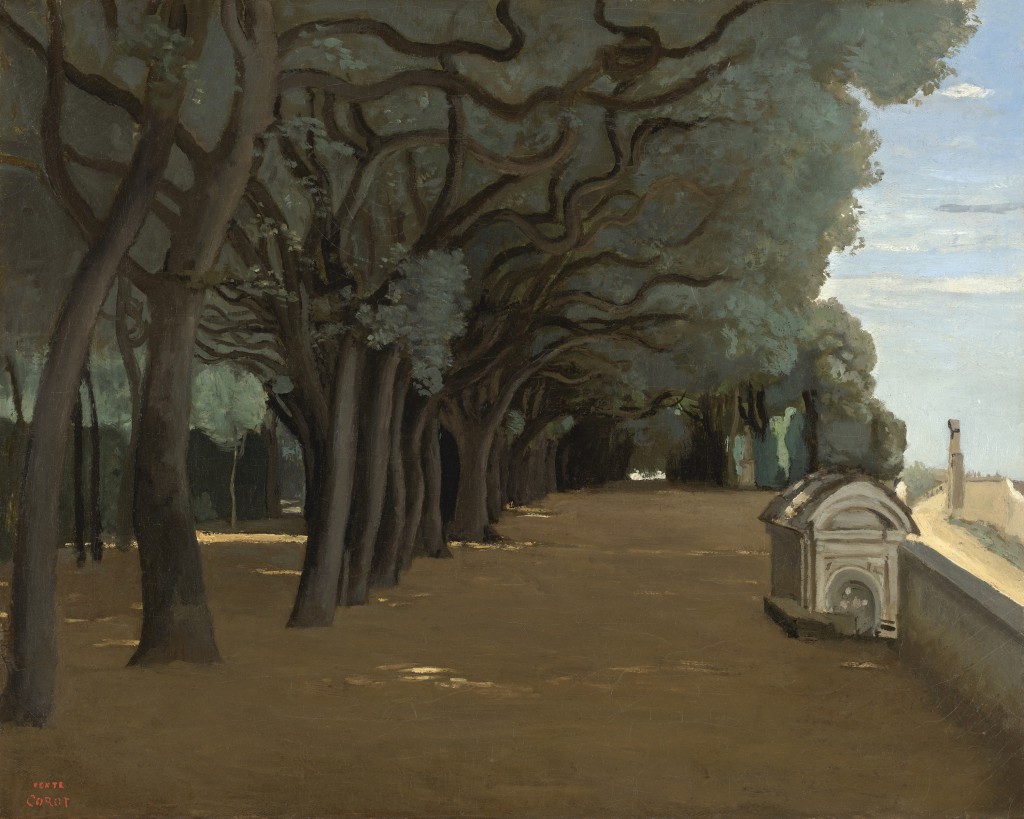Jean-Baptiste-Camille Corot (1796 - Paris - 1875)
The Terrace of the Villa Doria Pamphili, Rome 1826-7
Oil on canvas, 37.5 x 46.5 cm
Bearing the estate stamp lower left VENTE / COROT
On the stretcher a wax seal reading Vente Corot
SOLD / VERKAUFT
Provenance:
- The artist's studio
- Corot estate sale, Paris, Hôtel Drouot, Vente Corot, 26 May 1875, lot 8, sold for F440 (as Rome: villa Pamphili)
- Georges Lemaistre, great-nephew of Corot (purchased at the Vente Corot in 1875)
- Vente Lemaistre, 1902
- Henri Darasse
- Paris, Hôtel Drouot, Henri Darasse estate sale, 6 December 1909 (sold for F3,000)[1]
- Private collection, California (until 1961)
- London, Sotheby's, auction sale, 2 December 1970, lot 17
- Richard L. Feigen & Co., New York
- New York, Sotheby's, auction sale, 27 October 1988, lot 26
- Private collection
Literature:
Alfred Robaut, L'oeuvre de Corot, catalogue raisonné, Paris 1905, II, p. 38, no. 98, repr. p. 39
Alfred Robaut, L'oeuvre de Corot, catalogue raisonné, Paris 1965, II, p. 38, no. 98; repr. p. 39; IV, repr. p. 194
The Villa Doria Pamphili and its large park are located on the Via Aurelia Antica in Rome - to the west of Trastevere and only a short distance from the Vatican.[2] The terrace which Jean-Baptiste-Camille Corot chose to depict in the present oil study is no longer extant. It was once located in the park to the north of the Villa.
A certain indifference to detail characterizes many of the oil sketches and small-format paintings Corot executed towards the end of his first stay in Rome (1826-7). Architectural detail and precise definition of vegetation are almost entirely omitted. The sinuously intertwined branches of the trees seem to be precursors of the simplified forms favoured by Félix Vallotton. Set against a wall at the right of the image is one of the fountains common to nineteenth-century Rome.[3]
Corot's focus in this study lies on colouristic qualities and the changing effects of light. This focus contributed to the spontaneity and fluidity of the works he executed on his first stay in Rome. These works may appear to have something improvisatory about them but they are in fact meticulously composed. The line of trees at the left and the wall at the right form diagonals that converge on a vanishing point - the distant point of light at the end of the promenade. This use of the golden section as a compositional device was to be adopted later by nineteenth-century photographers. Corot's achievement consists in his pioneering skills in lending solid compositional structure to a randomly selected segment of nature.
The two teachers who instructed Jean-Baptiste-Camille Corot in the basic tenets of classical landscape painting were the painters Achille-Etna Michallon and Jean-Victor Bertin. From the start, both artists actively encouraged him to make studies directly from nature in the tradition of Pierre-Henri de Valenciennes. Both had been pupils of Valenciennes. The twenty-nine-year-old Corot set out for Italy at Bertin's instigation in the autumn of 1825. He arrived in Rome in November and wasted no time in exploring the historic and artistic attractions of the city and its environs. He rapidly produced a wealth of drawings and paintings. He was to continue to do this tirelessly throughout his three-year stay in Rome. Robaut's catalogue raisonné of Corot's oeuvre records over two hundred drawings and approximately one hundred and fifty small-format paintings - études d'après nature, or simply, études, as Corot himself described his Italian landscapes. Corot's first stay in Italy was the most important period in his artistic career. The present oil study is a work from this key period.[4]
Corot's skills as a plein-air painter clearly matured at a rapid pace. His initial practice was to work side-by-side with painters of his own age but after only a few months of working in their company sur le motif his talents outstripped theirs. By March 1826, he had earned the informal title notre maître from his French fellow-painters and friends.[5]
The studies Corot executed on his first stay in Italy are highly valued by present-day collectors. They rank among the masterpieces of nineteenth-century landscape painting and are the most highly sought-after works of Corot's entire oeuvre.
[1] See Kunst und Künstler: illustrierte Monatsschrift für bildende Kunst und Kunstgewerbe, 5/VII, Berlin 1909, p. 283. [2] For a history of the Villa Pamphili, see Carla Benocci (ed.), Villa Doria Pamphili, Rome 2005. [3] We are grateful to Professors Raimund Wünsche and Arnold Nesselrath for their research assistance. [4] Paysages d'Italie. Les peintres du plein air (1780-1830), exhib. cat., Galeries nationales du Grand Palais, Paris, 3 April-9 July 2001 and Centro Internazionale d'Arte e di Cultura di Palazzo Te, Mantua, 1 September - 16 December 2001, Paris 2001, p.189 ff. [5] Robaut, Documents sur Corot, II, p. 84 (Bibliothèque Nationale, Cabinet des Estampes, Yb.3.949 4to).

